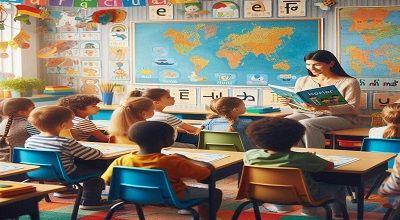Supporting Multilingual Students
Supporting multilingual students in the early grades is crucial for their academic success and overall well-being. Multilingual students bring diverse linguistic and cultural backgrounds to the classroom, and with the right support, they can thrive. Here are some strategies and best practices for supporting multilingual students in the early grades:
Create a Welcoming Environment:
- Make sure the classroom environment is inclusive and welcoming for all students, regardless of their language background.
- Display multicultural and multilingual materials to celebrate diversity.
Understand Language Development:
- Familiarize yourself with the stages of language development in children. Understanding how children acquire language will help you provide appropriate support.
Cultural Awareness:
- Be aware of the cultural backgrounds of your students and show respect for their cultural norms and traditions. This will help create a sense of belonging.
Individualized Support:
- Recognize that every multilingual student is unique, and their language proficiency and needs may differ. Provide individualized support when necessary.
Supportive Pedagogy:
- Implement strategies that promote language development, such as vocabulary-building activities, language-rich discussions, and opportunities for students to practice speaking, listening, reading, and writing.
Collaboration with Families:
- Maintain open communication with the families of multilingual students. They can provide valuable insights into their child’s language development and cultural needs.
Use of Bilingual Resources:
- Make use of bilingual resources, books, and materials to support students in their home languages.
Language Assessment:
- Conduct regular language assessments to track students’ language development and identify areas where they may need additional support.
Peer Interaction:
- Encourage multilingual students to interact with their peers. Peer support can be valuable for language development.
Professional Development:
- Stay updated on best practices for supporting multilingual students by attending workshops, webinars, or training sessions.
ESL (English as a Second Language) Support:
- If your school offers ESL or ELL (English Language Learner) programs, make sure that multilingual students have access to these resources.
Leverage Technology:
- Use technology and educational apps that offer language support and reinforcement.
Promote Literacy:
- Encourage reading in both the students’ home languages and English. This can improve their overall language skills.
Culturally Relevant Curriculum:
- Incorporate diverse cultural perspectives into the curriculum. This not only benefits multilingual students but also enhances the learning experience for all students.
Patience and Positive Reinforcement:
- Be patient and provide positive reinforcement for efforts made by multilingual students. Celebrate their progress and growth.
Peer Tutoring and Mentoring:
- Pair multilingual students with proficient English-speaking peers to provide support and encouragement.
Professional Collaboration:
- Collaborate with other educators, specialists, and support staff in your school to ensure that multilingual students receive the necessary support and accommodations.
Advocate for Resources:
- Advocate for the necessary resources and support within your school to ensure that the unique needs of multilingual students are met.
Summary
Remember that multilingual students bring valuable assets to the classroom, such as language diversity and problem-solving skills. By providing the appropriate support and fostering a culturally inclusive environment, you can help them succeed academically and feel a sense of belonging in the school community.
